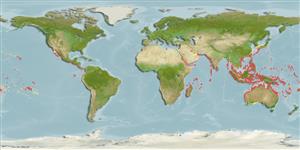Common names from other countries
Environment: milieu / climate zone / depth range / distribution range
Ecología
marino; salobre asociado a arrecife; rango de profundidad 0 - 20 m (Ref. 48637). Tropical
Indo-Pacific: East Africa to Samoa and the Hawaiian Islands.
Tamaño / Peso / Age
Maturity: Lm ? range ? - ? cm
Max length : 7.5 cm TL macho / no sexado; (Ref. 11344)
Short description
Claves de identificación | Morfología | Morfometría
Espinas dorsales (total) : 7; Radios blandos dorsales (total) : 9; Espinas anales: 1; Radios blandos anales: 8. Brown with irregular spots; dorsal and caudal fins with bands in females, dusky in males; often with dark brown saddle below each of the dorsal fins (Ref. 2798); characterized further by having upper five pectoral rays with free tips and sixth ray partly free; three branches on upper four pectoral rays; rounded caudal fin; longitudinal scale series 37-38; predorsal scales 18-20, reaching or nearly reaching interorbital space; cheek and opercle without scales; presence of fleshy double flap from edge of cheek into notch at posterior end of upper lip; ctenoid body scales, becoming cycloid on abdomen, breast, base of pectoral fin and nape; depressed head, width greater than depth; depth of body 4.3-5.5 in SL (Ref. 90102).
Inhabits intertidal seaward reef flats (Ref. 37816, 48637). Also found in shallow reefs near shore (Ref. 90102).
Life cycle and mating behavior
Maturities | Reproducción | Spawnings | Egg(s) | Fecundities | Larva
Benthic spawner.
Randall, J.E. and M. Goren, 1993. A review of the gobioid fishes of the Maldives. Ichthyol. Bull. J.L.B. Smith Inst. Ichthyol. (58):1-37, 5 pls. (Ref. 9360)
IUCN Red List Status (Ref. 130435)
CITES (Ref. 128078)
Not Evaluated
Threat to humans
Harmless
Human uses
Herramientas
Special reports
Download XML
Fuentes de Internet
Estimates based on models
Preferred temperature (Ref.
115969): 24.2 - 29.3, mean 28.2 (based on 3609 cells).
Phylogenetic diversity index (Ref.
82804): PD
50 = 0.5000 [Uniqueness, from 0.5 = low to 2.0 = high].
Bayesian length-weight: a=0.01023 (0.00477 - 0.02194), b=3.02 (2.84 - 3.20), in cm Total Length, based on LWR estimates for this (Sub)family-body shape (Ref.
93245).
Nivel trófico (Ref.
69278): 3.4 ±0.5 se; based on size and trophs of closest relatives
Resiliencia (Ref.
120179): Alto, población duplicada en un tiempo mínimo inferior a 15 meses (Preliminary K or Fecundity.).
Fishing Vulnerability (Ref.
59153): Low vulnerability (10 of 100).
